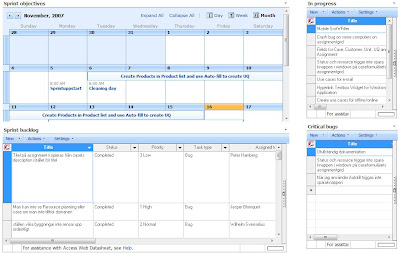Team rooms
 Do you remember those old "computer rooms" in school. You remember the smell? Well, sometimes agile smells just like that. I don't know how many times I've heard about agile teams being referred to small conference rooms just to be seated together. Rooms not adapted for so many people for such a long time. I wonder how many failures of agile projects are the results of bad working environment...
Do you remember those old "computer rooms" in school. You remember the smell? Well, sometimes agile smells just like that. I don't know how many times I've heard about agile teams being referred to small conference rooms just to be seated together. Rooms not adapted for so many people for such a long time. I wonder how many failures of agile projects are the results of bad working environment...Our team moved into our room exactly a year ago. We were so happy that we finally got our team room. The previous tenants had used the room for two guys. We were four and I believe the room is adapted for a group of that size.
When we max our resources we are now 9 guys and a girl. And the room both smells like and looks like that old computer room in High School. So, my highest priority is now: project Exodus. Moving out from the team room. There are larger rooms, but I guess the problem crept up on us. Now, it must change. Team rooms are nice, but adapted team rooms are brilliant.




 We've actually finished the sprint. Well, the demo is tomorrow, and we're dropping the release to operations tomorrow. But I think everything else is running. I tested our clients tonight and just finished that task. Long day, in other words. I know agile means no overtime but since I'm taking the morning off I wanted to make sure that I know the quality of the release.
We've actually finished the sprint. Well, the demo is tomorrow, and we're dropping the release to operations tomorrow. But I think everything else is running. I tested our clients tonight and just finished that task. Long day, in other words. I know agile means no overtime but since I'm taking the morning off I wanted to make sure that I know the quality of the release.
















